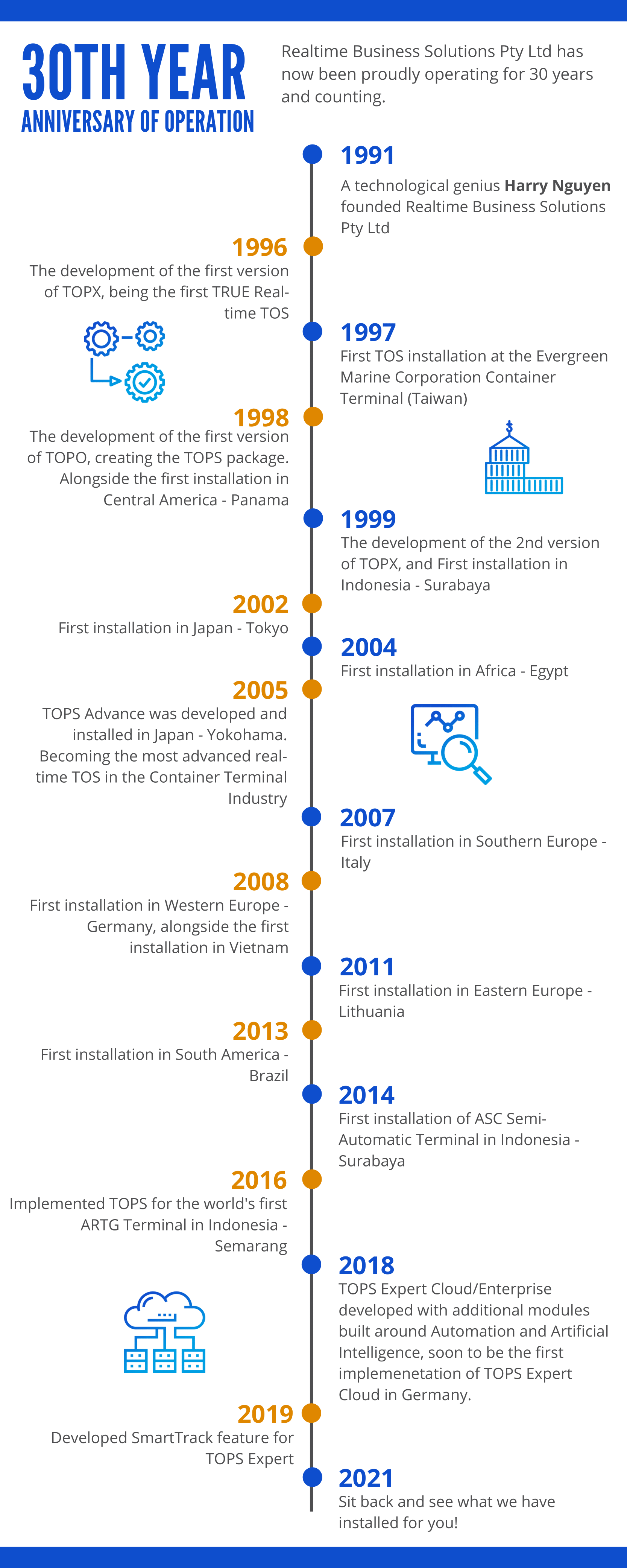RBS 30 Year
Anniversary
2020 Challenges Still Lingering in 2021
Current Developments in the Port Industry
RBS 30 YEARS IN OPERATION

RBS enters the new year with a milestone marking our 30th anniversary in operation. Since founded in 1991, continually focusing on software development to enhance terminal capabilities has granted RBS opportunities to connect with fantastic terminal operators and industry experts worldwide. RBS team’s collective efforts in Sydney, Australia, combined with their global partners, led to outstanding product breakthroughs.
We have also witnessed a great deal of change in the last three decades since the industry has endured several technology landscape shifts, fluctuating economies, and evolving standards. However, last year’s landslide events upended the entire world and have granted many of us alike valuable lessons that grew to development and improvement areas. Being present and involved in these changes contributes to our expanding knowledge as we are inspired to innovate further and strengthen our partnerships. As a result, RBS has developed unique products over the years, which offer a holistic solution driving innovation and efficiency for our clients.
OVER THE YEARS
Rolling out the first version of the graphical container planning, control, and monitoring system, TOPX, in 1996 put RBS on the map for being the first true real-time TOS to hit the market. A year later, TOPO, a data management system developed to stand with TOPX, becoming TOPS and offered ports and terminals a complete state-of-the-art solution. Henceforth, RBS TOS lead terminal installations across the globe, stretching its clientele across the seas to Asia, Europe, Africa, and even South America.
RBS focuses on continual innovation in technology abreast delivering premium services. Since introducing Simone, a 3D Simulation module in 2012, technological growth became one with RBS’ development team. By 2014, RBS implemented is newly powerful automation module in Semarang, Indonesia.
Constant iteration to improve design and functionality in 2017 compelled RBS to develop TOPS Expert Cloud, a full TOS entirely on the cloud while also exhibiting true real-time. Due to the highly sophisticated architecture, by 2018, both TOPS Cloud and Enterprise versions were available with added modules of AI while supporting automation. SmartTrack is the most recent product development, an extension of TOPS Expert, offering operators intelligent capabilities to calculate the shortest path to execute operations.

VISION
RBS’ achievements reflect the dedicated efforts of the founder, Harry Nguyen, and developers which continue to push boundaries and nurture ideas that facilitate, streamline, and develop better prospects for our clients. As a company, we have learned a great deal and are devoted to cultivating RBS’s vision of offering guidance that prepares terminal operators alike for uncertainty and a better future.
We thank all our clients for their loyal support and for choosing us as your TOS provider – it would not have been possible without you!
2020 CHALLENGES STILL LINGERING IN 2021

Container volume rebounds reveal promising signs of resilience despite the ongoing battle with COVID-19 impacts. Although many countries are experiencing a gradual increase in demand as it makes up for the losses at the beginning of 2020, trades in all continents are yet to recover fully.
Many anticipated a better start to the year; however, the aggressive virus resurgence in nations have enforced state-wide lockdowns throughout the holidays. Not only does this detriment the local economy, but it also generates grave repercussions for the global supply chain. Exports and imports cannot move as intended, disrupting container flow as mutating strains of the virus impose restrictions on movement and travel. As a result, the carrying on effects of 2020 has crept into the new year. Few challenges to see in the upcoming months:
WORKING IN A SOCIALLY DISTANCED WORLD
Unfortunately, 2021 has not been able to escape the virus’s grasp as its rapid speed of mutation has proved to be incredibly challenging to navigate working environments. Last year, the world leveraged the internet collaborative and communicating tools to continue the business. This new way of working in a socially distanced world will most likely stick this year forward too. Ports and terminals will increasingly choose cloud technology, while container handling equipment will integrate automation technology. Although these approaches are progressive and opportunistic, the areas of concern spawn when standards omit clearly defined conduct. As a result, working in a socially distanced world will counterintuitively push business backward rather than forwards.
Already automated operations executed with automatic equipment were able to continue as it was pre-pandemic. However, given the nature of industry sectors such as seafarers and ports transporting goods persevered and continued essential work. They confronted a dilemma that established a trade-off between maintaining resources and digitalizing (project development). Substantial financial resources were exhausted to compensate for the cargo volume losses at the pandemic’s initial stages, forcing operators to conserve resources to remain operational and active. Consequently, operators faced a dilemma of choosing between investing in port development and digitalization or sustaining business.
Industries have endured enough to gauge the requirements necessary for moving forward and have somewhat understood the risks associated with whichever strategies they decide to adopt. Depending on the current system – legacy or agile, transitioning into a digital landscape could conjure challenges throughout or even after installation, or it can be seamless, respectively. Therefore, project development may be outside the scope of near-future plans, but it is crucial to institute incremental and proactive steps that facilitate heightened communication and innovation.
MASTERING NEW TECHNOLOGY
The global crisis exposed the flaws deep within current systems, which helped cultivate better operating ways and expedite the digital economy. It has offered technological experts the opportunity to develop a specially curated product to tackle new problems existing today. However, fear for new technology and innovations emerges due to humans’ natural aversion to uncertainty.
Through trials and few testimonials, businesses tend to engage and muster the courage to adopt the new technology. Another hurdle arises from the amount of time invested in training personnel to master the product. The broader scope that the software product covers, the more training it will require – which terminal operators must factor while running their business simultaneously. This challenge only magnifies if performance is a priority and there is an insufficient number of employees to allow divided focus. It can also be an issue if management cannot afford to take tasks off their hands to undergo training. Despite the time invested to familiarize with the newly implemented products, it will prove worthwhile and crucial to securing the competitive advantage to advance in the digital economy.
GLOBALIZATION NO MORE?
The lessons learned from 2020 have been nothing short of dire as the crisis ultimately overthrew standard models and conventional practices. Globalization used to be a principal goal shared amongst terminals worldwide to strengthen the global supply chain. However, the pandemic rendered delayed shipments, port congestion, unemployment, and endless predicaments, which generated inefficiencies, indicating trade localization as a safer alternative.
Reducing overseas reliance and opting for regional trade spares ports from enforcing a mandatory two-week quarantine – a significant factor impacting the timeframe a shipment leaves the supplier and reaches the customer. It also boosts the local economy as it centralizes on creating more jobs within the country, inherently improving delivery speed and overall customer satisfaction. Nations intending to reduce their reliance to keep pace may need restructuring to alleviate the global supply chain disruption’s financial duress.
Although returning to the former hyper-globalized trade system is unlikely, ports less digitalized and dependent on offshore products will encounter few trade localization issues. They will need to reassess their global ties and determine the areas requiring a restructure to ensure it can adapt to post-pandemic conditions that favor their business performance. Fine-tuning a new model to meet business requirements may also be a task. It will still facilitate operators to navigate unchartered territories to understand the latest maritime and container industry’s foundations.
CURRENT DEVELOPMENTS IN THE PORT INDUSTRY

Controlling the pandemic has proven most challenging as its rapid pace of mutation attributes to is increased virality and contagion. Consequently, finding the best route possible to combat the global pandemic tests combined with the economic crisis while achieving operational efficiency has been difficult for the port industry. Container volumes have almost reached original levels pre-pandemic, and activity has started to pick up while port project developments have taken prevalence.
Over the past couple of months, there have been a rising number of port expansions. Expanding a port’s infrastructure, whether it is into rail, road, yard space, greener technology, or increasing berthing space, ultimately widens its scope of capabilities. As a result of covering the operational spectrum, it equips operators with the tools to explore methods that improve operations, achieve higher target performance, and generate additional jobs.
Project expansions of developing or retrofitting rail and road networks are rising, particularly in nations focusing on trade localization. It is a new strategy to maintain a constant free flow of container movement within their region and is a proactive response to the stalled shipments stuck on overseas carriers earlier last year. Ever since, terminal operators have been dealing with its impacts by turning away container receivals, facing late deliveries, and managing clogged warehouses. Therefore, reducing the distance by focusing on inland or intermodal terminal tenfold reduces cost and time. Optimizing the available pool of resources is also crucial, especially since the container volume has dipped after the massive surge of goods from the Christmas frenzy. New and continuously changing regulations introduced due to the virus mutations enforce ports to prioritize optimization and efficiency.
Port and terminal operators are increasingly becoming environmentally aware of their carbon footprint as they realize the consequences of climate change inaction, as well as the long-term financial benefits. Environmentally friendly investments are now aligned with financial objectives as there are more readily available technology and products at affordable prices on the market. As a result, operators can cost-optimized and leverage better control over their resources such as energy consumption and wastage. The previous year demonstrated full-scale climate change effects with catastrophic events of extreme heat and torrential rain damaging port infrastructure drew upon ports to consider greener investments.
Unemployment rates have increased since the crisis, and governments’ have sought numerous avenues to improve these numbers across all industry sectors. Governments allocating funds to extend port operations that boost capacity and create job opportunities within their following region strengthen the overall supply chain. Furthermore, higher accessibility granting passage for more trade for importers and exporters warrant a dual benefit kickstarting the economy.
